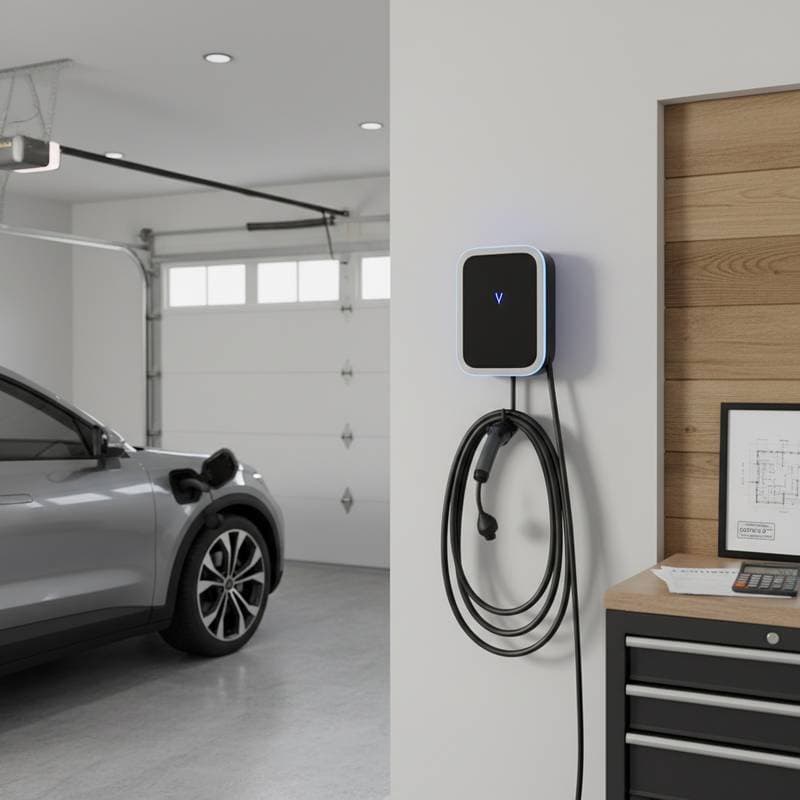EV Chargers Boost Home Value 11 Percent by 2025: Essential Insights
A Level 2 EV charger installation typically increases a home's resale value by approximately 11 percent by 2025. This enhancement appeals to buyers who prioritize electric vehicle readiness. Homeowners benefit from this upgrade as it positions the property in the expanding market for sustainable living.
Homebuyers increasingly seek properties equipped for electric vehicles. An EV charger serves as more than a practical addition; it represents a strategic investment. This feature draws in technology-oriented and environmentally aware purchasers, securing the home's relevance amid the rise of electric mobility.
Factors Influencing EV Charger Costs and Returns
Multiple elements determine the expense of an EV charger and its potential return on investment. Understanding these components enables precise budgeting and informed decisions.
Charger Types and Pricing
Level 1 chargers connect to standard 120-volt outlets and range in price from $300 to $600. These options provide basic charging but require extended times to fully charge a vehicle. In contrast, Level 2 chargers, priced between $500 and $1,200, demand a 240-volt circuit for faster performance. Prospective buyers value this efficiency, which contributes significantly to perceived property worth.
Electrical System Modifications
Installing a 240-volt line or adding a new breaker panel component costs $400 to $1,000. Properties with outdated electrical panels might require comprehensive upgrades, escalating expenses to $2,000 or more. These investments ensure compatibility with modern demands and enhance overall home safety.
Permitting and Regulatory Costs
Municipal permits for installations typically cost $100 to $250. Certain utility providers and local governments offer rebates that offset these fees. Researching available incentives early maximizes financial benefits.
Professional Labor Expenses
Electricians licensed for such work charge $75 to $125 per hour. A standard installation requires 4 to 6 hours, depending on site conditions. Selecting experienced professionals minimizes risks and ensures compliance with standards.
Installation Distance Considerations
When the distance from the electrical panel to the charging location exceeds 25 feet, costs rise by $200 to $500. This increase accounts for additional conduit, wiring, and labor. Planning the layout optimizes expenses and maintains aesthetic appeal.
Advanced Features for Enhanced Appeal
Chargers with Wi-Fi connectivity and energy monitoring capabilities add $150 to $300 to the total. These smart options resonate with contemporary buyers who value integration with home automation systems. Such features elevate the property's market position.
Allocate an additional 10 to 15 percent of the budget for unforeseen issues, particularly in older homes with intricate wiring. Comprehensive planning mitigates these potential overruns.
Installation Options: DIY or Professional
Deciding between self-installation and hiring experts depends on the home's existing setup and the individual's expertise.
Suitable Scenarios for DIY Installation
- The property already features a dedicated 240-volt outlet adjacent to the parking area.
- The selected charger employs a plug-in connection rather than permanent wiring.
- The installer possesses familiarity with mounting procedures and basic electrical verification.
- All local regulations and product guidelines receive strict adherence.
Reasons to Engage a Professional
Opt for a licensed electrician in these situations:
- Electrical panel enhancements or new circuit installations prove necessary.
- The charger requires hardwiring into the system.
- Extensive trenching or conduit placement extends beyond simple access.
- Outdoor setups demand specialized weather-resistant measures.
- Handling permits or conducting inspections falls outside personal capabilities.
High-voltage work carries inherent risks, including electrical shock or fire hazards. Always disconnect power at the main breaker prior to commencing. Use insulated tools and gloves, and verify circuit deactivation with a tester. Adhering to these protocols protects both the installer and the property.
Ongoing Maintenance and Warranty Guidance
EV chargers demand minimal routine care, yet proactive measures prolong functionality and reliability.
- Conduct monthly visual inspections for frayed cables or damaged enclosures.
- Wipe connectors using a dry cloth to avoid buildup that leads to corrosion.
- Verify ground fault circuit interrupter functionality biannually to uphold safety standards.
- Ensure secure cable attachment to prevent strain on mounting points.
- Update software on connected models to optimize performance and security.
Manufacturers provide warranties lasting 3 to 5 years on most units. Extended coverage options address issues like power surges or cable abrasion. Retain all documentation, including receipts and warranty details, in an accessible location near the electrical panel.
Critical Safety and Compliance Measures
Prior to any installation, verify adherence to essential requirements.
- Obtain necessary permits, as most jurisdictions mandate them for 240-volt additions.
- Assess breaker compatibility to avoid overloading the existing panel.
- Implement proper grounding to safeguard equipment and vehicles from electrical faults.
- Employ weatherproof housings and conduits for exterior placements.
- Perform load calculations to confirm the household's total electrical demand remains within panel limits.
Homes with service panels under 100 amps often require subpanel additions or full upgrades. Neglecting these evaluations risks frequent breaker trips or hazardous overheating.
Steps to Implement Your EV Charger Upgrade
Begin the process by evaluating the electrical panel's capacity and the parking area's configuration. Solicit estimates from at least two licensed electricians, ensuring each includes permitting costs and rebate applications. Focus on comprehensive pricing rather than isolated equipment costs.
For homeowners anticipating a sale, prioritize a professional, mid-tier setup that emphasizes durability and tidiness. Reliability outweighs brand prestige in buyer assessments. Preserve records of permits, inspections, and warranties to demonstrate value during property showings.
Actionable Steps for EV Charger Installation
- Evaluate the electrical panel's amperage rating and review the garage or driveway setup.
- Obtain detailed quotes from a minimum of two certified electricians.
- Submit rebate applications prior to commencing work.
- Time the project for favorable weather conditions to expedite completion.
- Organize all paperwork for future warranty claims and property resale documentation.
This upgrade not only enhances immediate usability but also aligns the home with emerging trends in sustainable transportation. Buyers recognize the long-term advantages, translating to stronger market positioning and higher returns.










